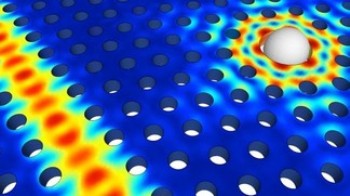Mar 22 2013
EPFL scientists have achieved optical trapping of sub-micrometre particles at unprecedented low powers of the field inducing the trap. The trapping phenomenon is also accompanied with cavity back-action effects, which result from the mutual interaction between the position of the trapped particle and the cavity field.

Optical tweezers are scientific instruments used to control and displace micro-particles. They were invented in the 70s and were the inspirational idea that led to the 1997 Nobel Prize for optical cooling and trapping. This technique exploits the restoring forces induced on small particles by carefully designed spatial variations of a tightly focused light. Optical tweezers have become widespread devices to manipulate neutral particles of sizes ranging from a few hundred nanometres to a few micrometres but have since now been of limited use for the optical trapping of dielectric particles smaller than 100 nanometres because of the strong field spatial variation required on this scale. Moreover they are bulky and complex optical systems with only a weak, if any, selectivity of the trapped particle with respect to its, shape, size or refractive index.
Many schemes have been proposed in order to overcome these limitations, most of them exploit the large field gradients existing in the vicinity of light guiding structure like integrated waveguides, optical cavities, dielectric ridge waveguides or plasmonic structures. These approaches are limited by the large amount of optical power required and mostly allow particle confinement only in one or two dimensions.
In an article just published in Physical Review Letters, the group of Prof. R. Houdré at the Laboratory of Quantum Optoelectronics (LOEQ) present the first experimental demonstration of an integrated hollow optical cavity, which selectively traps sub-wavelength particles with unprecedented low optical powers of less than 100 microwatts. The optical nanocavities are designed within so-called photonic crystal structures, which are periodically nanostructured dielectric materials. The optical traps are then implemented in a microfluidic chip. The trapping is achieved by light, pumped through a guide consisting of a missing line of holes that provides light throughout the structure to the optical cavity where the sharp field variation creates the binding forces.
In a proof-of-concept experiment, a particle has been trapped at varying light wavelengths and powers. The researchers have also shown that the perturbation of the cavity mode by the trapped particle generates a noticeable resonance wavelength shift. This change in wavelength is associated with the Brownian motion of the particle within the resonant trap. Two trapping regimes have been discovered. While one of these regimes is comparable in nature to classical optical tweezers, the second is very unique as the optical field generating the restoring force is only present when the particle is moving toward the outside of the trap and vanishes when the particle is well located within the centre of the trap.
Future prospects include the use of microfluidic integrated hollow photonic crystal cavities for single particle sorting and trapping in a well controlled orientation, analysis, advanced spectroscopy, the investigation and manipulation of biological microorganisms such as small bacteria, cell organelles and viruses. These results constitute a first step towards the manipulation of single particles of the size of a virus on a CMOS-compatible chip using ultralow optical powers. This could potentially lead to new generations of portable Lab-on-a-Chip devices for Point-of-Care diagnosis.
Observation of Backaction and Self-Induced Trapping in a Planar Hollow Photonic Crystal Cavity, Nicolas Descharmes, Ulagalandha Perumal Dharanipathy, Zhaolu Diao, Mario Tonin, and Romuald Houdré, Phys. Rev. Lett. 110, 123601 (2013).